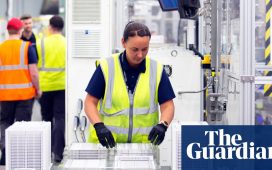This article is an on-site version of our Energy Source newsletter. Sign up here to get the newsletter sent straight to your inbox every Tuesday and Thursday
Good morning, and welcome back to Energy Source, coming to you from New York.
The International Energy Agency is out with a new report this morning, urging oil and gas companies to dole out more cash for the energy transition or risk losing out in the path to net zero. Betting on carbon capture alone is an “illusion”, the IEA says.
“The uncomfortable truth . . . is that successful clean energy transitions require much lower demand for oil and gas, which means scaling back oil and gas operations over time,” wrote IEA executive director Fatih Birol in the report, which found less than 1 per cent of investment in clean energy came from oil and gas companies.
The report comes ahead of next week’s UN COP28 summit in Dubai, where the phaseout of fossil fuels will be a key tension among world leaders.
Elsewhere, in the oil market, crude prices fell sharply yesterday after Opec+ postponed its planning meeting from Sunday to the middle of next week. Traders interpreted the move as sign the cartel is struggling to agree on production cuts.
In the US, travellers for the Thanksgiving holiday will pay the lowest prices at the pump since January. Airfare prices have tumbled too. AAA expects 55.4mn Americans will travel this year for the holiday, a figure that is among the three highest in the 23 years it has kept record.
Today’s newsletter focuses on the Joe Biden administration’s upcoming rules to isolate China from its electric vehicle buildout. It’s a tall order given Beijing’s dominance in the supply chain.
Thanks for reading. And for our US readers, happy Thanksgiving. — Amanda
Biden administration set to draw the line on China and EVs
The Biden administration is entering the eleventh hour to release pivotal rules on sourcing Chinese inputs for electric vehicles.
The president’s signature climate law, the Inflation Reduction Act, extended a lucrative tax credit for EVs to propel the country closer to its target of making 50 per cent of all new vehicle sales electric by the end of the decade.
But the money came with caveats. Starting in January 2024, to qualify for the full tax credit, vehicles cannot include battery parts from a “foreign entity of concern” (ie China). The rule extends to critical minerals the following year as part of the administration’s effort to rival China’s technological and manufacturing supremacy in the sector.
“It’s not exactly a secret that [the IRA] is trying to prevent China from becoming a de facto winner and trying to bolster a domestic industry on electrification,” said Mark Wakefield, global co-leader of automotive and industrials at consultancy AlixPartners.
Car and battery makers still don’t know how Biden will draw the line on China in the tax credit. Too loose, and the US risks losing out on domestic industry, not to mention the heightened vulnerability to supply shocks. Too stringent, and it could bring the country’s electric vehicle rollout to a halt.
“Treasury and the Department of Energy have to almost find a Goldilocks answer here,” said Corey Cantor, senior electric vehicle associate at BloombergNEF, which estimates more than $100bn of investments has been announced in the North American electric vehicle supply chain since the IRA’s enactment last year.
Supporters of the most stringent IRA requirements include some domestic manufacturers and West Virginia senator Joe Manchin, a key author of the climate law. Last week, the senator penned a letter to Treasury secretary Janet Yellen, urging her to employ “the strictest metrics possible”.
A useful starting point, Manchin argued, were the recent commerce department rules for semiconductor subsidies that make companies ineligible if 25 per cent or more of the business’s ownership is Chinese.
“It is necessary to balance between speed of deployment and creating secure stable, sustainable, and diverse supply chains for the long term,” said Abigail Hunter, acting director at non-profit SAFE’s Center for Critical Mineral Strategy, who is pushing for a “strict enforcement” of the law but thinks projects should be evaluated on a case-by-case basis.
A strict ruling could mean Chinese licensing agreements, US subsidiaries of Chinese companies, and Chinese joint ventures would not qualify for the tax credit. Projects like these include Ford’s planned factory in Michigan and Chinese battery company Gotion’s announced factories in the Midwest which have become political flashpoints for US-China relations in recent months.
But some industry and climate groups such as Ceres worry a hardline on China will hamper the US electric vehicle rollout.
“Collaboration between US battery and automobile manufacturers and Chinese industry players can pave the way for technology and knowledge dissemination,” wrote Zach Friedman, Ceres’ director of federal policy, in a July comment to the Treasury department.
A recent report by S&P Global Commodity Insights found the US would struggle to meet demand for critical minerals such as nickel by relying only on domestic sources and free-trade partners.

The Alliance for Automotive Innovation, a trade association, is pushing against an “overly broad” application of foreign entity of concern (FEOC) and has urged the Treasury to allow vehicles with insignificant traces of Chinese material to qualify for the tax credit.
“Imagine an EV that has otherwise run the gauntlet and complied with all IRA eligibility requirements . . . but is deemed completely ineligible because of a trace amount of a critical mineral or component coming from an FEOC? That wouldn’t make sense — or good policy,” said John Bozzella, president and chief executive of the alliance. Currently, only a fifth of electric vehicle models qualify for the whole tax credit in the US under the latest rules.
How the Biden administration rules on the tax credit will be a sign of its priorities when it comes to climate versus industry, as well as the future of business co-operation between the world’s two largest economies. Chinese investment in the US plunged 58 per cent to $2.5bn last year — its lowest level for more than a decade, according to Rhodium Group.
“It’s a pretty big and existential piece of this whole industrial strategy,” said Milo McBride, energy, climate, and resources analyst at the Eurasia Group. “The Biden administration is trying to strike a balance between its energy transition and its industrial strategy goals and it’s a difficult square to circle . . . the elephant in the room is of course China.”

Job moves
-
LG Energy Solution, Korea’s largest battery maker, appointed president Kim Dong-myung as chief executive on Wednesday, replacing Kwon Young-soo.
-
Universal Hydrogen, a US aviation start-up, appointed Anastasiya ‘Stasy’ Pasterick as chief financial officer on Monday. The announcement comes days after her resignation as CFO of Nikola, a role she held for just six months.
-
NRG, a US energy group, has parted ways with chief executive Mauricio Gutierrez following a months-long campaign by activist investor Elliott Management. NRG’s chair of board of directors Lawrence Coben has been appointed interim chief.
-
Sasol, a South African chemicals and energy company, appointed Simon Baloyi as chief executive on Friday, succeeding Fleetwood Grobler, who will continue to serve in an executive adviser role.
Power Points
Energy Source is written and edited by Jamie Smyth, Myles McCormick, Amanda Chu, Tom Wilson and David Sheppard, with support from the FT’s global team of reporters. Reach us at energy.source@ft.com and follow us on Twitter at @FTEnergy. Catch up on past editions of the newsletter here.
Recommended newsletters for you
Moral Money — Our unmissable newsletter on socially responsible business, sustainable finance and more. Sign up here
The Climate Graphic: Explained — Understanding the most important climate data of the week. Sign up here












